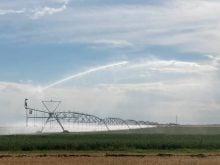Aquaculture is one of the fastest growing food production industries in the world, climbing to 37.9 million tonnes in 2001 from 13 million tonnes in 1990.
Murray Drew of the University of Saskatchewan’s Prairie Feed Resource Centre thinks prairie farmers and processors can benefit from this growth.
“The typical farmed-salmon diet is composed of 50 percent fish meal and 14 percent fish oil, which provides a feed source that is virtually the same as in the wild,” Drew said.
“Not only does it help to produce farmed fish with a flesh quality that is similar to that of their wild counterparts, it helps to maintain the immune system and optimize disease resistance.”
Read Also

Dennis Laycraft to be inducted into the Canadian Agricultural Hall of Fame
Dennis Laycraft, a champion for the beef industry, will be inducted into the Canadian Agricultural Hall of Fame this fall.
But fish meal supply is inconsistent, its cost fluctuates more than plant proteins and the demand for aquaculture feed is expected to increase by 300 percent in the next 10 years. This indicates an opportunity for plant protein, but the switch won’t be easy.
“A plant protein replacement for fish meal in a salmon diet, for example, must be at least 60 percent protein, contain few antinutritional factors and have a stable source and price.
“We also know from previous research into soybean as a replacement, that negative reactions to the feed are avoided by including no more than 20 percent plant protein in a fish diet. Furthermore, to meet the 40 percent protein level required by the aquafeed, protein concentrates from plants must be used.”
Investigation of peas as a source of aquafeed showed that they contain about 22 percent protein but also antinutritional factors such as fibre, which prevents nutrient digestion. However, when the peas were processed to produce protein concentrate, crude protein levels remained much the same and digestibility improved.
Drew said similar studies were conducted into replacing fish oil.
Fish oil is rich in omega three fatty acids, particularly highly unsaturated fatty acids. It also contributes to the nutrient quality of the fish carcass.
But again, the supply is inconsistent and it is increasingly used for human food and by industry.
Also, all the available supply of fish oil for aquaculture will be used by 2009, preventing industry expansion.
Because flax oil is high in omega three fatty acids like fish oil, it is a potential fish feed ingredient. Flax oil is unstable and difficult to handle, but oil in whole flax seed is stable and has a longer shelf life.
It is a rich source of linolenic acid and also has a high percentage of crude protein.
On the other hand, Drew said, flax contains two important antinutritional factors: glycosides and a soluble fibre that is advantageous for humans but not for fish.
The glycosides can be removed by a heat treatment and the soluble fibre can be extracted.
Researchers have found that a combination of heat, moisture and pressure removed the fibre to improve digestibility without lowering crude protein.
When this processed flax was fed to rainbow trout as a percentage of their usual fishmeal diet, the trout grew just as well as the control fish receiving only fishmeal.
When the flax was further processed by mixing it with pea and canola protein concentrates, the digestibility was also high.
Trout gained as much on a 40 percent flax and pea protein mix as control fish receiving the usual fishmeal feed.
“The aquaculture industry is moving toward vegetable meal instead of fishmeal, and our studies have definitely shown that Saskatchewan feed ingredients have potential in this area,” Drew said.
Processing is the key to fulfilling this potential. Prices must be competitive with fishmeal and oil and Drew believes this is not a problem.
“In fact, there are Saskatchewan companies currently moving toward commercialization of pea protein and flax dehulling. The preparation of fish feed is only a short step from there.”














